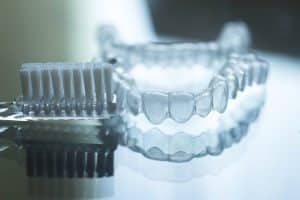Living with Invisalign can be a straightforward journey when you have the right information. These clear aligners are a convenient and discreet way to straighten teeth, but they do require some adjustments to your daily routine. By following practical tips and understanding what to expect, you can ensure a smooth and comfortable experience with Invisalign.
Explore these essentials of living with Invisalign in Puyallup, covering tips for comfort, success, and maintaining your aligners.
Understanding the Basics of Living with Invisalign
What Is Invisalign?
Invisalign is a modern orthodontic solution designed to straighten teeth using clear, removable aligners. These aligners are custom-made and are swapped out every one to two weeks to gradually shift your teeth into their ideal positions. Unlike traditional braces, Invisalign is nearly invisible and can be removed for eating, drinking, and cleaning.
Adjusting to Invisalign
When starting with Invisalign, the first few days might feel slightly uncomfortable. Here’s what to expect:
- Tightness and Pressure: This is a sign that your aligners are working.
- Speech Changes: You might notice a slight lisp initially, but it usually disappears within a few days.
- Increased Saliva Production: Your mouth adjusts to having something new inside it.
These initial challenges typically improve within a week as your mouth adapts. Understanding these changes is a key part of living with Invisalign.
Tips for Maintaining Comfort with Invisalign
Adjusting to Invisalign can be easier when you take a few practical steps to stay comfortable. Here are some tips that can help:
1. Ease into the First Few Days
The first few days with Invisalign may bring mild discomfort, but there are simple ways to manage it:
- Apply orthodontic wax to areas where the aligners irritate your gums.
- Stick to softer foods like yogurt, mashed potatoes, and soups until your mouth adjusts.
- Remove your aligners briefly if the pressure feels too intense, but don’t do this too often.
2. Stay Hydrated
Drinking plenty of water keeps your mouth hydrated and helps prevent irritation. Dryness can make wearing aligners less comfortable, so aim to sip water throughout the day. Avoid sugary or acidic drinks while wearing your aligners to protect both your teeth and the aligners.
3. Manage Discomfort with Simple Remedies
While aligner adjustments may cause temporary soreness, these techniques can help:
- Use over-the-counter pain relievers if needed.
- Switch to a new set of aligners before bed. Sleeping through the initial adjustment period can minimize discomfort.
4. Protect Your Aligners from Damage
Avoid eating or drinking anything other than water with your aligners in place. Food particles and heat can damage the aligners or cause them to discolor. Always store them in their case when not in use.
By following these steps, living with Invisalign becomes a lot more manageable, and you’ll likely feel more comfortable as you adjust to the routine.
Common Mistakes to Avoid While Living with Invisalign
To get the best results and avoid unnecessary setbacks, it’s important to steer clear of these common mistakes.
1. Skipping the 22-Hour Wear Time
Wearing your aligners less than the recommended 22 hours per day can significantly delay your progress. Every skipped hour adds up and may result in extended treatment time or less effective results.
2. Neglecting to Clean Your Aligners Regularly
Failing to clean your aligners can lead to:
- Bacteria buildup, which can cause bad breath or oral health issues.
- Stains that make the aligners less discreet.
Make cleaning your aligners a part of your daily routine to keep them clear and odor-free.
3. Using Hot Water on Aligners
Rinsing or soaking your aligners in hot water can warp the plastic and ruin their fit. Always use lukewarm water to clean or rinse them.
4. Forgetting to Remove Aligners Before Eating or Drinking
Aligners are not designed to withstand the pressure of chewing. Eating with them in can damage them and trap food particles. Similarly, drinking beverages other than water can cause stains and weaken the aligners over time.
5. Storing Aligners Carelessly
Misplacing or damaging your aligners can set you back in your treatment. Always store them in their case when not in use. Leaving them out can expose them to bacteria or lead to accidental loss.
By avoiding these common pitfalls, you’ll ensure your Invisalign treatment stays on track and delivers the best possible results. Small changes in daily habits can make a big difference when living with Invisalign.
Quick FAQs About Living with Invisalign
Here are answers to some of the most frequently asked questions about living with Invisalign, providing clarity on common concerns.
1. Does Invisalign Hurt?
Mild discomfort is normal, especially when starting a new set of aligners. This is a sign that your teeth are moving. The discomfort typically subsides after a few days. Over-the-counter pain relievers can help during this adjustment period.
2. Can I Drink Coffee with Invisalign?
You should remove your aligners before drinking coffee. Coffee can stain the aligners and cause discoloration. Always brush your teeth before putting the aligners back in to prevent staining and sugar buildup.
3. How Do I Keep Track of My Aligner Schedule?
Staying consistent with aligner changes is crucial for progress. Use a calendar, mobile app, or reminders to stay on track with your schedule. Some orthodontists may provide apps or tools to make this easier.
4. What Happens if I Lose an Aligner?
Contact your orthodontist immediately. They may advise wearing the previous aligner or skipping to the next one, depending on your progress. Keep your aligners in their case when not in use to reduce the risk of loss.
5. How Do I Clean My Aligners?
Rinse them with lukewarm water and brush gently with a soft toothbrush. You can also use Invisalign cleaning crystals or an approved cleaning solution. Avoid using toothpaste, as it can be too abrasive and cause scratches.
These FAQs address common concerns and provide actionable tips for a seamless experience. By understanding these details, living with Invisalign becomes easier and more manageable.
Conclusion
Living with Invisalign doesn’t have to be complicated. With the right habits and knowledge, you can ensure a comfortable and successful experience. By wearing your aligners consistently, keeping them clean, and avoiding common mistakes, you’ll stay on track to achieve the smile you’ve been working toward.
If you’re considering Invisalign or are currently using it, staying informed is the best way to make your treatment journey as smooth as possible.
Take the First Step Toward Your Best Smile
Living with Invisalign can transform your smile and boost your confidence, and at Smiles Orthodontics, we’re here to make that journey as smooth as possible. Whether you’re just starting with Invisalign or need expert guidance to ensure success, our experienced team is dedicated to helping you every step of the way.
At Smiles Orthodontics, we offer personalized care, advanced technology, and flexible payment plans to meet your unique needs. Schedule a free consultation with Dr. Bobby Virk or Dr. Helena Skountrianos, both highly regarded orthodontic specialists, and discover how we can help you achieve the smile you’ve always wanted.
Don’t wait—contact us today to explore the treatment options that fit your lifestyle and get started on the path to a brighter, healthier smile!



